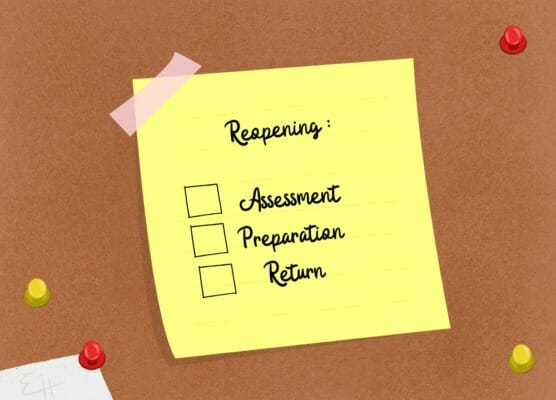Back-to-work checklist: Steps to consider in emerging from a shutdown
As workplaces reopen after the coronavirus shutdown, here is a free reopening checklist from The Conference Board to help your HR department plan the important safety, operational and legal decisions:
ASSESSMENT
▢ Review and reset business strategy and the implications for current/future staffing
▢ Assess need to return to the physical workplace and, if so, what work can still be done virtually
▢ Analyze effectiveness of remote work and infrastructure, including collaboration platforms and videoconferencing
▢ Assess community readiness, including whether schools and health support facilities are open, allowing workers with children and elder-care issues to return
▢ Review safety and reliability of public transit, plus employees’ comfort with using it
▢ Check into the viability of all vendors of HRIS systems, payroll services and others to deliver critical employee-related services
▢ Assess availability of masks (especially where mandated by law), gloves, thermal scanners, removable forehead strips, hand sanitizers, etc.
▢ Consider your ability to provide ADA reasonable accommodations (PPE example: nonlatex gloves) or religious accommodations (example: face masks that allow for specific religious garb).
▢ Review employee readiness (those who are/were ill, displaced workers) and willingness to return

PREPARATION
▢ Create a workplace sanitation and deep-cleaning regimen. Create procedures and training for employee assistance and hygiene
▢ Restructure the work environment, which may include seating arrangements for greater social distancing, defensive plexiglass shields, rerouted employee movement flows (colored carpeting paths or rope lines) to minimize clusters at entry/exit points, crowded elevators and narrow hallways
▢ Install “contactless” options: soap dispensers in the restrooms, hand sanitizer dispensers, alternatives to ID badge swiping, etc.
▢ Determine health status of those returning to work either through temperature scanning, daily self-assessment or a “fitness-for-duty” documentation from a medical professional certifying the worker doesn’t have coronavirus
▢ Review performance targets and possibly reset goals and metrics
▢ Review and revise (if necessary) any HR decisions, policies and procedures that were adopted or changed during the crisis (see box below)
▢ Create new HR policies regarding worker safety, work stoppage or alternative work arrangements in the event of a resurgent COVID-19 (or other disease) outbreak
▢ Institute new HR policies regarding large in-person meetings, company events/celebrations, use of common areas and eating areas
▢ Review recruiting and hiring processes, which may include decisions regarding hiring freezes, compensation, background checks, drug screenings and remote I-9 form documentation review
▢ Distribute a communication plan to help workers prepare for a return to work, understand policy changes, and accept the conditions under which they will be expected to perform
▢ Prepare for security, mental health and other professionals to receive workers in the early days of return
▢ Set guidelines for allowing suppliers, visitors, clients, customers, and meeting attendees into the workplace and how they will be screened
RETURN
▢ Distribute masks and required protective gear, plus instructions for use
▢ Set up (and train staff on) new screening/heath check entry stations and other safety procedures
▢ Provide training or reskilling necessary for existing jobs or redeployment—and for any new technology
▢ Remind staff of employee wellness programs, including physical, mental and financial elements
▢ Create/revise efforts to measure (and take action on) the engagement level of your employees
▢ Continually communicate to further rebuild the culture. Address past difficult decisions (effects of layoffs, lost colleagues, affected families, etc.). Communicate plans for company renewal. Celebrate milestones and, as they come, celebrations of “wins”







